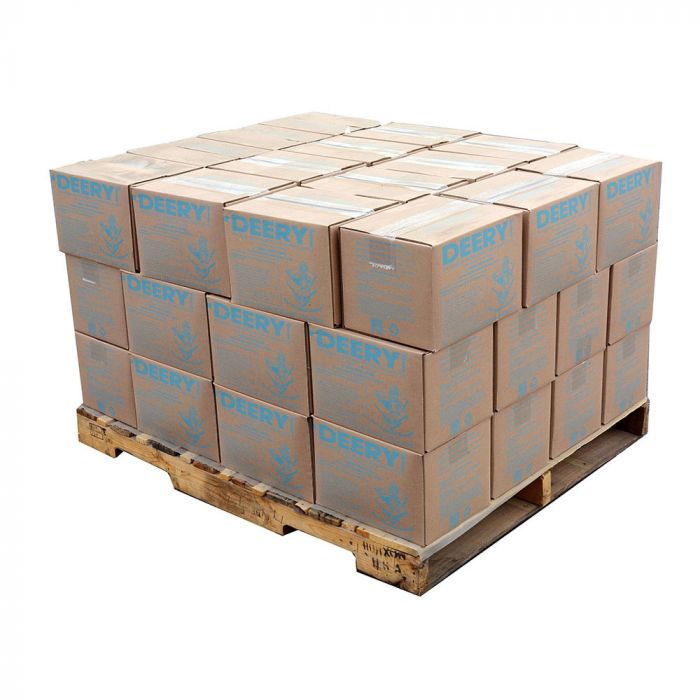Deery Super Stretch Crack Sealant / Filler - 36 Boxes
Add AK Make it a Biz Success Pack - Free With Purchase

- Make $7,200 Per Pallet
- 3 to 4 Year Lifespan
- 30 Minute Fast Dry
Have questions? We’re here to help!

Never Run Out of Asphalt Crack Sealants All Season Long with the Deery Crack Filler (36 Boxes)
Filling cracks in asphalt is key to protecting the lifespan of the pavement. Our Deery Super Stretch Asphalt Crack Sealant is a fast-curing crack filler that dries in just 30 minutes. Everyone can drive on it virtually immediately.
- Commercial-grade crack filler used on high-traffic asphalt surfaces
- Save money when buying a complete pallet of asphalt crack filler vs 1/2 pallet. Call to save: 1-866-399-5562
- 10-year shelf life. Store and use it as needed
Deery Super Stretch parking lot crack filler is easy to use. Just place the 30-lb bag directly in a direct-fire melter or oil-jacketed melter, heat to 380-400°F, and go!
Applying Deery Super Stretch Crack Filler
Deery Superstretch crack sealers are suitable for pavements 40°F (4°C) in temperature or warmer. Once the product has reached the right melting temperature, use a melter-applicator like our RY10 or RY10 Pro, RY10 Elite. A larger melting machine and putting some product in a crack pour pot to apply is also an option.
The crack filler can be used in high-heat situations like deserts. But it has also been proven to stay flexible down to -0°F. That's a great range, and it guarantees fixes will hold through all types of weather.
We do not recommend leaving the crack filler simmering at high heat for long periods of time. It can be cooled and reheated as needed, but prolonged heating can damage the sealer.
What Our Satisfied Customers Say:
“Top Shelf! I started Wyoming Asphalt Repair with Asphalt Kingdom equipment and material. I am very impressed with the how great the equipment runs and how great the material works. Their customer service and sales team is top shelf!!“
Johnny Bublich
President, President of Wyoming Asphalt Repair, LLC
“Well made machine. Everything feels nice and solid construction. Delivery was hassle free. Filled about four thousand feet of cracks in 4 days. Cracks varied from 1/4 to 1-1/4 inch. The super stretch crack filler remained pretty solid on a 98 degree day. I would recommend the machine and the super stretch crack filler.”
Srinivas Thimmappa
CEO, PE and Consultants NY LLC
Use Deery Super Stretch Crack Filler the same places the pros use it:
- City streets
- Parking lots
- Asphalt joints to new pavement
The asphalt crack filler is perfect for areas that receive a lot of ice and snow. Plus, it's highly waterproof and salt-resistant. Use it on any asphalt cracks or joints up to 1.5" wide. With wider cracks, take a look at our patching and pothole options.
This is a half pallet listing. If more crack filler is necessary, give Asphalt Kingdom a call and see how we can help. Our team of experts would love to help find the correct quantity and shipping solution.
We ship the best asphalt driveway crack fillers to your place of business. Send us an email or give us a call for more information.
Note: We are pleased to offer FREE SHIPPING within the Continental United States. Additional charges may apply for residential deliveries, limited access locations, lift-gate services, and remote areas. A surcharge of $150 per pallet applies to shipments going to the West Coast (Arizona, California, Colorado, Idaho, Montana, Nevada, New Mexico, Oregon, Utah, Washington, and Wyoming).
For orders shipping to Alaska and Hawaii: We will ship your items to your preferred freight forwarder within the United States. From there, you will handle the arrangements for final delivery to your location.
QUESTIONS AND ANSWERS
| Questions | Answers |
|---|---|
| Is the sealant compatible with the current equipment and specific asphalt mix types used by contractors? | The Deery crack sealant is compatible with most standard melters, designed to melt quickly and apply smoothly for efficient crack filling. |
| What special storage conditions are needed to prevent the sealant from deteriorating before use? | Sealant blocks are packaged for easy storage with minimal space requirement and extended shelf life. |
| Under what range of environmental conditions (temperature, humidity) can the sealant be effectively applied without performance issues? | The Deery crack sealant is formulated to perform optimally in a wide range of temperatures, ensuring reliable application in various climates. |
Have questions? We’re here to help!

| Shipping Weight | 1220 lbs |
| Shipping Length | 48 |
| Shipping Width | 40 |
| Shipping Height | 36 |
| Flow @ 140°F (60°C) | 1 mm maximum |
| Low Temperature Flexibility | Pass @ 0°F (-18°C) |
| Softening Point | 200°F (93°C) minimum |
| Resilience | 60% minimum |
| Curing Time | 30 minutes maximum |
| Recommended Application Temperature | 380 - 400°F (193 - 204°C) * |
| Maximum Heating Temperature | 400°F (204°C) |
| Warranty | Manufacturer warrants that these products meet applicable ASTM, AASHTO, Federal or State specifications at time of shipment. Techniques used for the preparation of the cracks and joints prior to sealing or filling are beyond our control as are the use and application of the products; therefore, manufacturer shall not be responsible for improperly applied or misused products. |
5
5 stars
100% (19)
4 stars
0% (0)
3 stars
0% (0)
2 stars
0% (0)
1 star
0% (0)
Share your thoughts with other customers
Top customer reviews
- Great product the state of Idaho uses this product on the highwaysI have used this product for over 20 years
I have a parking lot I Rexburg Idaho we have severe winters and the parking lot is 40 years old it this crack filler really works - Outstanding product and even better service!What really stood out was the outstanding service from Asphalt Kingdom. Jud and the team truly know their stuff and go above and beyond for their customers. We needed a pallet on short notice, and they delivered it even faster than expected. Couldn’t ask for a better experience—professional, responsive, and reliable from start to finish. Thank you so much - Chattahoochee Valley Sealcoating, LLC
- Deery works perfectThe Deery works perfect and arrived on time with no problem.
- Crackfilling and Sealcoating are really simpleEverything is fine. It took me a little bit of a learning curve. The videos on the website are really helpful for a starter like me. I realize that Crackfilling and Sealcoating are really simple. You just need to get the right equipment for you. I'm happy with my purchase looking forward to doing more business with you in the future
- It's worth Sharing!I'm satisfied with it. Great products. Everything that I've purchased works great! It's worth Sharing!
- We love the product...We love the product. We use it around our facility just doing maintenance on concrete and asphalt. So far the repairs are holding up pretty well!
- Will order soon!The RY10 PRO worked well and the crack sealers helped us have it sealed. We will just wait for the time that we need to seal again.
- Expectations metThe experience has met our expectations.
- Works Great!Works Great!
- It's better than what other peopleI think it's good and the sealer itself I think it's better than what other people have used in the past.
- PerfectPerfect!
- I was about to order moreSounds fine, as a matter of fact I was about to order more.
- I'm totally happy with itI'm totally happy with it. In fact I just got you recommending this product to somebody else, another property owner here. I know he'll be placing an order this winter.
- We could not be happier!We could not be happier with our business relationship with Asphalt Kingdom. The products are top quality and the customer service is excellent. Thanks guys.
- Wonderful ServiceGlenn is the bomb!!!! Thank you for your wonderful service!
- Great service and follow upThanks for the great service
- Great Quality & ServiceFantastic product, and service. Pallets always arrive within days of ordering and the quality of the crack filler is superb. We order from Asphalt Kingdom exclusively.
- great productProduct is great to work with
- Fast shippingWe ordered on May 2nd and received our shipment on May 8th. Appreciate the fast shipment and we will be ordering from you again.
Start your Asphalt Maintenance Business with the most in-demand service!
Looking at doing crack repair as a business? Make your success inevitable with these valuable add-ons, yours free with purchase at Asphalt Kingdom!
You get:
- Role-Playing Video with Judd Burdon: find out exactly what to say when you pitch your business to customers, and how to answer their most common objections.
- Crack Filling Proposal Template: a professionally designed form that you can fill in and print off — convert more business when you look pro from the get-go.
- Customizable Social Media Templates: swipe these great graphics and post them on your Facebook or Google My Business pages — get valuable leads with these proven templates!
- Phone Script written by Judd Burdon for you or your sales team to use when prospecting new business.
- Exclusive Access to AK Round Table Meetings: join us on a weekly Zoom call and get answers to any questions you have about your business.
You don't need to spend valuable time learning in the school of hard knocks — take advantage of the experience we've gained helping 1000s of clients start their own business.
Just click 'Make it a Biz' when you add this product to the cart, and we'll send you all of the above absolutely free. Welcome to your asphalt kingdom.









